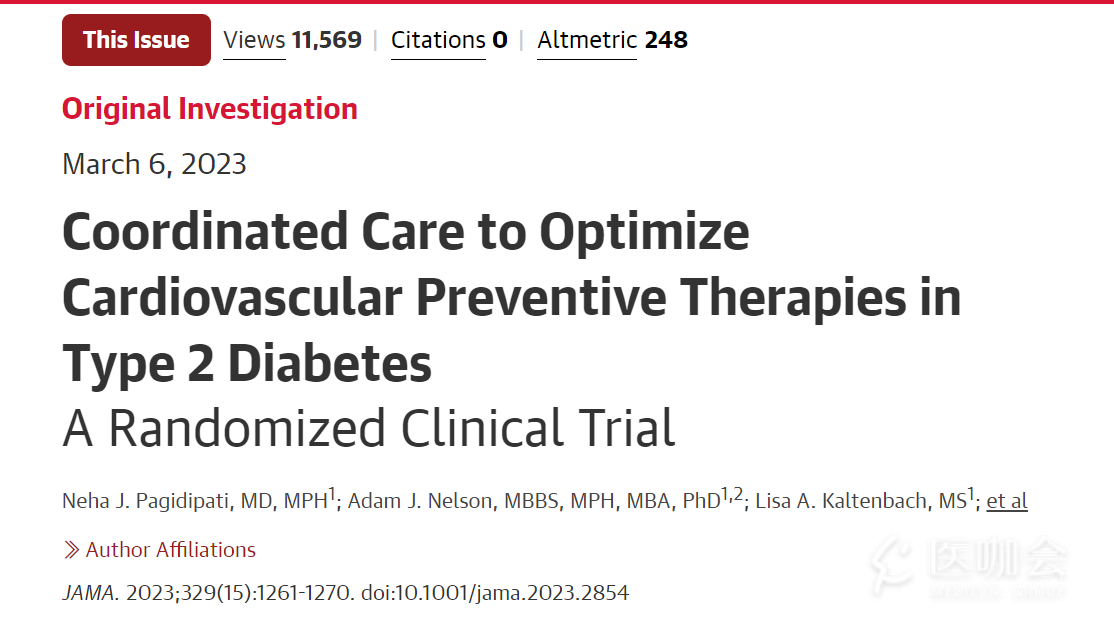JAMA:优化2型糖尿病心血管预防治疗的协调护理:一项随机临床试验
注:本文由小咖机器人翻译整理
期刊来源:JAMA
文献发表时间:2023-03-06
原文链接:https://jamanetwork.com/journals/jama/article-abstract/2802167
关键点内容如下:
问题
在患有2型糖尿病和动脉粥样硬化性心血管疾病的成年人中,协调的、多方面的干预能否增加3种循证疗法的处方?
调查结果
在全美心脏病诊所的一组随机临床试验中,干预组的参与者更有可能接受所有3种治疗(高强度他汀类药物、血管紧张素转化酶抑制剂或血管紧张素受体阻滞剂、钠-葡萄糖协同转运蛋白2抑制剂和/或胰高血糖素样肽1受体激动剂)。反馈组与常规护理组相比(分别为173/457[37.9%]和85/588[14.5%],差异为23.4%)。
意义
一项协调的、多方面的干预措施增加了成人2型糖尿病和动脉粥样硬化性心血管疾病患者的3组循证治疗处方。
摘要内容如下:
重要性
降低成人2型糖尿病患者动脉粥样硬化性心血管疾病风险的循证治疗在临床实践中未得到充分应用。
目标
评估、教育和反馈与常规护理的协调、多方面干预对2型糖尿病和动脉粥样硬化性心血管疾病成人患者比例的影响,所有3组推荐的循证治疗(高强度他汀类药物、血管紧张素转化酶抑制剂[ACEIs]或血管紧张素受体阻滞剂[ARBs]和钠-葡萄糖协同转运蛋白2[SGLT2]抑制剂和/或胰高血糖素样肽1受体激动剂[GLP-1RAS])。
研究对象
从2019年7月到2022年5月,43家美国心脏病诊所进行了集群随机临床试验,招募参与者,并随访至2022年12月。参与者是患有2型糖尿病和动脉粥样硬化性心血管疾病的成年人,尚未接受所有3组循证治疗。
干预措施
评估当地障碍,制定护理路径,协调护理,教育临床医生,向诊所报告数据,并为参与者(n=459)提供工具,而不是根据实践指南提供常规护理(n=590)。
主要结果和措施
主要结果是参与者在入组后6至12个月内接受所有3组推荐治疗的比例。次要转归包括动脉粥样硬化性心血管疾病危险因素的变化,以及全因死亡或因心肌梗死、卒中、失代偿性心力衰竭或紧急血运重建住院的复合转归(该试验无法显示这些差异)。
结果
在登记的1049名参与者(20家干预诊所的459名和23家普通护理诊所的590名)中,中位年龄为70岁,有338名女性(32.2%)、173名黑人参与者(16.5%)和90名西班牙裔参与者(8.6%)。在最后一次随访(97.3%的参与者为12个月)时,干预组(173/457[37.9%])比常规护理组(85/588[14.5%])更有可能接受所有3种治疗,差异为23.4%(调整后的比值比[OR],4.38[95%CI,2.49至7.71];P<.001),并且更有可能接受3种治疗中的每一种(与基线相比,高强度他汀类药物干预的变化从66.5%到70.7%,而常规治疗的变化从58.2%到56.8%[校正OR,1.73;95%可信区间,1.06-2.83];ACEIs或ARBs:干预组从75.1%到81.4%,常规组从69.6%到68.4%[校正OR,1.82;95%可信区间,1.14-2.91];SGLT2抑制剂和/或GLP-1RAS:干预组从12.3%到60.4%,常规组从14.5%到35.5%[调整OR,3.11;95%可信区间,2.08-4.64])。干预与动脉粥样硬化性心血管疾病危险因素的变化无关。干预组457名参与者中有23名(5%)出现复合次要结果,常规护理组588名参与者中有40名(6.8%)出现复合次要结果(调整后的风险比为0.79[95%CI为0.46~1.33])。
结论和相关性
一项协调的、多方面的干预增加了成人2型糖尿病和动脉粥样硬化性心血管疾病患者3组循证治疗的处方。
英文原文如下:
Key Points
Question Can a coordinated, multifaceted intervention increase the prescription of 3 evidence-based therapies among adults with type 2 diabetes and atherosclerotic cardiovascular disease?
Findings In a cluster randomized clinical trial of cardiology clinics across the US, participants in the intervention group were more likely to be prescribed all 3 therapies (high-intensity statins, angiotensin-converting enzyme inhibitors or angiotensin receptor blockers, and sodium-glucose cotransporter 2 inhibitors and/or glucagon-like peptide 1 receptor agonists) after an intervention of assessment, education, and feedback vs those in the usual care group (173/457 [37.9%] vs 85/588 [14.5%], respectively, which is a difference of 23.4%).
Meaning A coordinated, multifaceted intervention increased prescription of 3 groups of evidence-based therapies in adults with type 2 diabetes and atherosclerotic cardiovascular disease.
Abstract
Importance Evidence-based therapies to reduce atherosclerotic cardiovascular disease risk in adults with type 2 diabetes are underused in clinical practice.
Objective To assess the effect of a coordinated, multifaceted intervention of assessment, education, and feedback vs usual care on the proportion of adults with type 2 diabetes and atherosclerotic cardiovascular disease prescribed all 3 groups of recommended, evidence-based therapies (high-intensity statins, angiotensin-converting enzyme inhibitors [ACEIs] or angiotensin receptor blockers [ARBs], and sodium-glucose cotransporter 2 [SGLT2] inhibitors and/or glucagon-like peptide 1 receptor agonists [GLP-1RAs]).
Design, Setting, and Participants Cluster randomized clinical trial with 43 US cardiology clinics recruiting participants from July 2019 through May 2022 and follow-up through December 2022. The participants were adults with type 2 diabetes and atherosclerotic cardiovascular disease not already taking all 3 groups of evidence-based therapies.
Interventions Assessing local barriers, developing care pathways, coordinating care, educating clinicians, reporting data back to the clinics, and providing tools for participants (n = 459) vs usual care per practice guidelines (n = 590).
Main Outcomes and Measures The primary outcome was the proportion of participants prescribed all 3 groups of recommended therapies at 6 to 12 months after enrollment. The secondary outcomes included changes in atherosclerotic cardiovascular disease risk factors and a composite outcome of all-cause death or hospitalization for myocardial infarction, stroke, decompensated heart failure, or urgent revascularization (the trial was not powered to show these differences).
Results Of 1049 participants enrolled (459 at 20 intervention clinics and 590 at 23 usual care clinics), the median age was 70 years and there were 338 women (32.2%), 173 Black participants (16.5%), and 90 Hispanic participants (8.6%). At the last follow-up visit (12 months for 97.3% of participants), those in the intervention group were more likely to be prescribed all 3 therapies (173/457 [37.9%]) vs the usual care group (85/588 [14.5%]), which is a difference of 23.4% (adjusted odds ratio [OR], 4.38 [95% CI, 2.49 to 7.71]; P < .001) and were more likely to be prescribed each of the 3 therapies (change from baseline in high-intensity statins from 66.5% to 70.7% for intervention vs from 58.2% to 56.8% for usual care [adjusted OR, 1.73; 95% CI, 1.06-2.83]; ACEIs or ARBs: from 75.1% to 81.4% for intervention vs from 69.6% to 68.4% for usual care [adjusted OR, 1.82; 95% CI, 1.14-2.91]; SGLT2 inhibitors and/or GLP-1RAs: from 12.3% to 60.4% for intervention vs from 14.5% to 35.5% for usual care [adjusted OR, 3.11; 95% CI, 2.08-4.64]). The intervention was not associated with changes in atherosclerotic cardiovascular disease risk factors. The composite secondary outcome occurred in 23 of 457 participants (5%) in the intervention group vs 40 of 588 participants (6.8%) in the usual care group (adjusted hazard ratio, 0.79 [95% CI, 0.46 to 1.33]).
Conclusions and Relevance A coordinated, multifaceted intervention increased prescription of 3 groups of evidence-based therapies in adults with type 2 diabetes and atherosclerotic cardiovascular disease.





